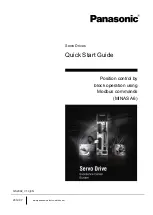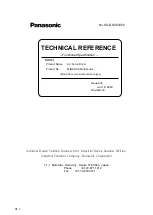
40
1)Calculation of equivalent capacity P0 of harmonic generating equipment
The "equivalent capacity" is the capacity of a 6-pulse converter converted from the capacity of consumer's harmonic
generating equipment and is calculated with the following equation. If the sum of equivalent capacities is higher than
the limit in Table 3, harmonics must be calculated with the following procedure:
2)Calculation of outgoing harmonic current
Outgoing harmonic current = fundamental wave current (value converted from received power voltage)
×
operation
ratio
×
harmonic content
⋅
Operation ratio: Operation ratio = actual load factor
×
operation time ratio during 30 minutes
⋅
Harmonic content: Found in Table 4.
3)Harmonic suppression technique requirement
If the outgoing harmonic current is higher than the maximum value per 1kW (contract power)
×
contract power, a
harmonic suppression technique is required.
4)Harmonic suppression techniques
Table 2 Conversion factors for FR-A701 series
Class
Circuit Type
Conversion Factor (Ki)
3
Three-phase bridge
(Capacitor smoothing)
With reactor (AC side)
K32 = 1.8
Table 3 Equivalent Capacity Limits
Received Power Voltage
Reference Capacity
6.6kV
50kVA
22/33kV
300kVA
66kV or more
2000kVA
Table 4 Harmonic content (Values of the fundamental current is 100%)
Reactor
5th
7th
11th
13th
17th
19th
23rd
25th
Used (AC side)
38
14.5
7.4
3.4
3.2
1.9
1.7
1.3
P0 =
Σ
(Ki
×
Pi) [kVA]
* Rated capacity: Determined by the capacity of the applied
motor and found in Table 5. It should be noted that the rated
capacity used here is used to calculate generated harmonic
amount and is different from the power supply capacity
required for actual inverter drive.
Ki: Conversion factor(According to Table 2)
Pi: Rated capacity of harmonic generating equipment
*
[kVA]
i : Number indicating the conversion circuit type
Table 5 Rated capacities and outgoing harmonic currents of inverter-driven motors
Applied
Motor
(kW)
Rated Current
(A)
Fundamental
Wave Current
Converted
from 6.6kV
(mA)
Rated
Capacity
(kVA)
Outgoing Harmonic Current Converted from 6.6kV (mA)
(With reactor, 100% operation ratio)
200V
400V
5th
7th
11th
13th
17th
19th
23rd
25th
5.5
19.1
9.55
579
6.77
220.0
83.96
42.85
19.69
18.53
11.00
9.843
7.527
7.5
25.6
12.8
776
9.07
294.9
112.5
57.42
26.38
24.83
14.74
13.19
10.09
11
36.9
18.5
1121
13.1
426.0
162.5
82.95
38.11
35.87
21.30
19.06
14.57
15
49.8
24.9
1509
17.6
573.4
218.8
111.7
51.31
48.29
28.67
25.65
19.62
18.5
61.4
30.7
1860
21.8
706.8
269.7
137.6
63.24
59.52
35.34
31.62
24.18
22
73.1
36.6
2220
25.9
843.6
321.9
164.3
75.48
71.04
42.18
37.74
28.86
30
98.0
49.0
2970
34.7
1129
430.7
219.8
101.0
95.04
56.43
50.49
38.61
37
121
60.4
3660
42.8
1391
530.7
270.8
124.4
117.1
69.54
62.22
47.58
45
147
73.5
4450
52.1
1691
645.3
329.3
151.3
142.4
84.55
75.65
57.85
55
180
89.9
5450
63.7
2071
790.3
403.3
185.3
174.4
103.6
92.65
70.85
No.
Item
Description
1
Installation of power factor
improving capacitor
When used with a series reactor, the power factor improving capacitor has an effect of
absorbing harmonic currents.
2
Transformer multi-phase
operation
Use two transformers with a phase angle difference of 30° as in -
,
-
combination
to provide an effect corresponding to 12 pulses, reducing low-degree harmonic currents.
3
Passive filter
(AC filter)
A capacitor and a reactor are used together to reduce impedances at specific frequencies,
producing a great effect of absorbing harmonic currents.
4
Active filter
This filter detects the current of a circuit generating a harmonic current and generates a
harmonic current equivalent to a difference between that current and a fundamental wave
current to suppress a harmonic current at a detection point, providing a great effect of
absorbing harmonic currents.
Содержание FR-A741-11K
Страница 7: ...MEMO ...
Страница 216: ...209 MEMO ...
















































